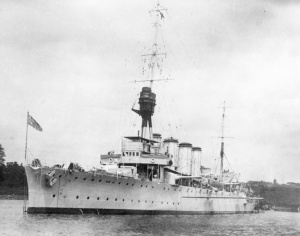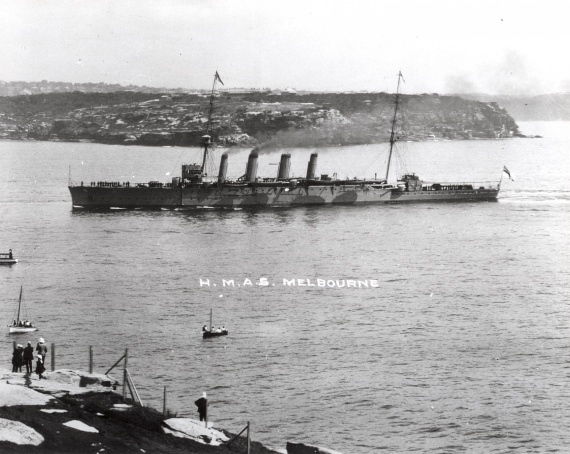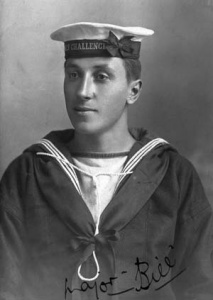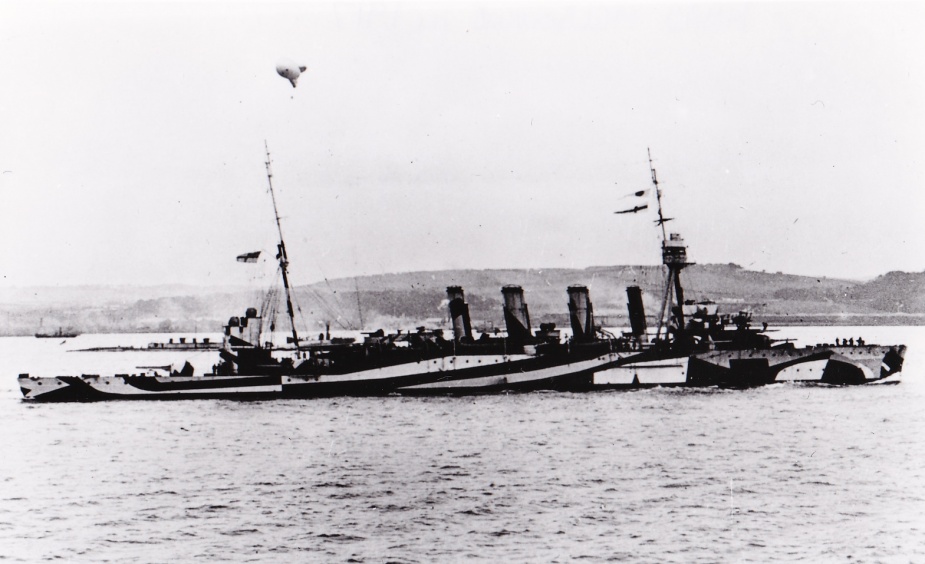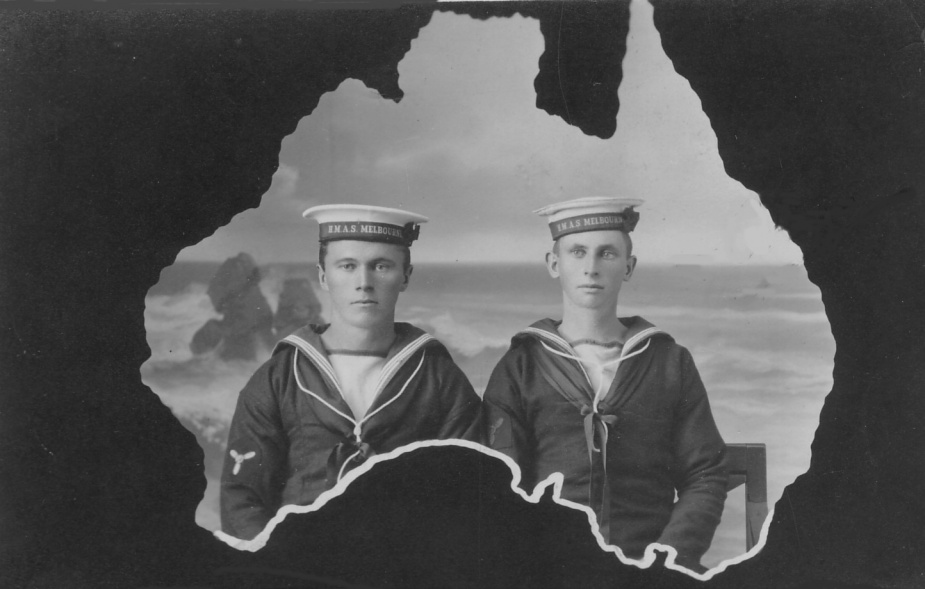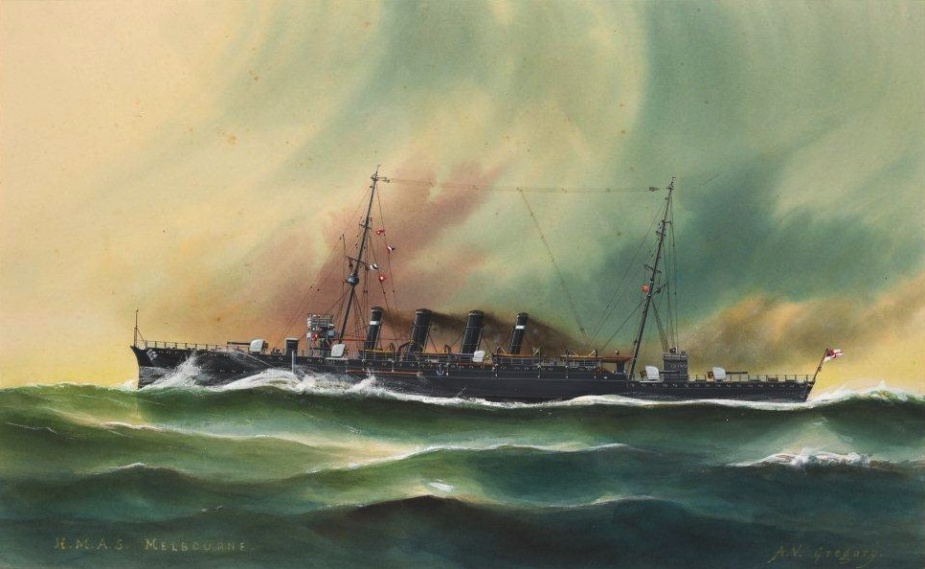HMAS Melbourne (I)
| Class |
Town Class |
|---|---|
| Type |
Light Cruiser |
| Builder |
Cammell Laird & Co Ltd, Birkenhead, England |
| Laid Down |
4 April 1911 |
| Launched |
30 May 1912 |
| Launched by |
Mrs Braund, daughter of Mr Barr Smith of Adelaide |
| Commissioned |
18 January 1913 |
| Decommissioned |
23 April 1928 |
| Dimensions & Displacement | |
| Displacement | 5400 tons |
| Length | 456 feet 10 3/8 inches |
| Beam | 49 feet 10 inches |
| Draught | 19 feet 7 inches |
| Performance | |
| Speed | 23.2 knots |
| Complement | |
| Crew | 485 |
| Propulsion | |
| Machinery | Parsons Turbines, Yarrow boilers, 4 screws |
| Armament | |
| Guns |
|
| Torpedoes | 8 x 21-inch torpedo tubes (submerged) |
| Awards | |
| Battle Honours | |
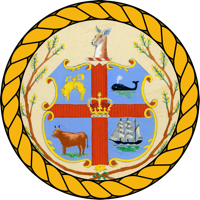
HMAS Melbourne commissioned at Birkenhead, England, on 18 January 1913 under the command of Captain Mortimer L’Estrange Silver, RN. The ship completed her delivery voyage from England when she arrived at Fremantle on 10 March 1913.
Following the outbreak of war in August 1914, Melbourne spent a brief period in Pacific waters as a unit of the Australian Squadron to prevent attacks by the German Pacific Squadron under Admiral Graf von Spee. She took part in the seizure of the German Pacific possessions, and on 9 September 1914 landed a naval party on Nauru Island to carry out the destruction of the wireless station. Her return to Sydney on 20 September 1914 ended this phase of operations. The cruiser covered 11,170 miles on Pacific patrols.
Her next task saw her proceed to Albany, Western Australia to become an escort for the first Australian & New Zealand troop convoy. Early on the morning of 29 October 1914 she was patrolling off King Georges Sound when the merchant vessel SS Essex attempted to enter the sound where the troop convoy was formed up. Melbourne signaled Essex to stop, but this order was ignored and it required a 6-inch shell fired by Melbourne across the stern of Essex to stop the merchant vessel blundering into the sound and the anchored troopships. On 1 November 1914 Melbourne sailed from Albany escorting in company with HMAS Sydney (I), HMS Minotaur and the Japanese cruiser Ibuki, the troop convoy comprising 38 transports. Detaching from the convoy in the Indian Ocean, Melbourne reached Colombo on 14 November, proceeding the following day for Gibraltar, arriving there on 5 December 1914. On 10 December the cruiser received orders to sail for the Azores to assist in the search for the cruiser Karlsruhe.
Arriving at Madeira on 12 December, Melbourne received orders to proceed direct to Bermuda for attachment to the North America and West Indies Stations for patrol duties. Operations began from Trinidad on 28 December 1914 when she departed that post with orders to search the coastal areas of Venezuela, Colombia and Panama for the Karlsruhe and her attendant supply ship.
The following twenty months (January 1915-28 August 1916) were spent as a unit of the North America and West Indies Squadron, maintaining a series of patrols in the West Indies with Jamaica as the centre point; and off Long Island and the entrance to New York Harbour with Halifax as the base. Squadron Headquarters were at Bermuda. Melbourne operated north to Halifax and south to the Para River, Brazil, taking in the Gulf of Mexico.
At the close of August 1916 Melbourne detached from the North America and West Indies Stations and proceeded for Devonport, where she arrived on 7 September. Following a month in port she departed for Scapa Flow, to become a unit of the 2nd Light Cruiser Squadron and part of the Grand Fleet.
A brief period of routine North Sea patrols ended in January 1917 when serious engine trouble forced her into dock at Birkenhead. She remained in dockyard hands until the end of June 1917.
On 27 June 1917 Melbourne sailed from Birkenhead to rejoin the Grand Fleet at Scapa and again became a unit of the 2nd Light Cruiser Squadron. The remainder of the war period was spent on routine patrols and fleet exercises in northern waters. She returned to Portsmouth on 30 November 1918. Melbourne took no part in any action at sea and suffered no casualties.
On 7 March 1919 her service in the European theatre ended when she departed Devonport for Australia, finally entering Sydney Harbour on 21 May 1919 after a leisurely cruise via Suez, Singapore and Darwin.
On 5 August 1919 Melbourne paid off and lay inactive at Sydney until she was recommissioned on 14 April 1920.
The period of 1920 to 1924 was spent mainly in Australian coastal waters, interspersed with spring cruises to Pacific Island territories, two visits to New Zealand and cruises to Timor and the Moluccas.
On the night of 21/22 January 1922 HMAS Melbourne was involved in the dramatic rescue of 18 people from the sinking US registered schooner Helen B Sterling. The Helen B Sterling had departed Newcastle in early January bound for San Francisco with a cargo of coal. The schooner encountered a storm north of New Zealand and began to sink. Fortunately the Helen B Sterling had a wireless on board and sent out a distress call which was received by Melbourne, then on a deployment to New Zealand waters.
Melbourne responded to the SOS and steamed at full speed through heavy seas and rising winds towards the position given by the schooner. At midnight on 21 January, when all hope appeared to be lost in finding the schooner, the stricken vessel was spotted using the cruisers searchlights. It was far too rough to get the cruiser alongside the schooner, so Melbourne launched its cutter with a 16 man volunteer crew to row across to the sinking vessel. Once they were close enough the cutters crew fired a line across to the schooner and then rigged a breeches buoy (basically a flying fox) which was used to bring the crew over to the cutter one by one. Amongst those rescued was the Master of the Helen B Sterling, his wife and 12 year old son, who was on his first trip to sea. Once on board the cutter the crew of the Sterling were rowed back to the Melbourne and then taken to Auckland, New Zealand where they were disembarked. Subsequently, the 16 men who manned Melbourne's cutter were each awarded a gold medal by the President of the United States for their skill and valour in effecting the rescue. The master's son, Leslie Harris, received various pieces of memorabilia following the rescue, among them an HMAS Melbourne tallyband which was eventually passed on to his grandson, Michael. Michael went on to join the RAN, and in 2009 Commander Michael Harris became the Commanding Officer of HMAS Melbourne (III).
On 29 September 1924 Melbourne again paid off, and lay at Sydney for a year before recommissioning on 8 October 1925 in preparation for a voyage to the United Kingdom. Departing Sydney on 23 November 1925, she reached Portsmouth on 30 March 1926. She returned to Australia in August.
The remainder of her active life as a unit of the Australian Squadron was spent at Port Phillip, Westernport and Sydney. On 9 February 1928 Melbourne sailed from Sydney for the United Kingdom. She arrived at Portsmouth on 12 April 1928 and paid off at that port on 23 April 1928. In December 1928 the ship was sold to Alloa Shipbuilding Co, Rosyth, Scotland, for £25,000. She was broken up in 1929.

